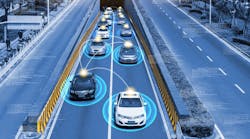The Networking Challenges Confronting Autonomous Vehicles
This article is part of the How to Overcome Autonomous-Vehicle Networking Challenges series and in the Automotive topic of our Library: Article Series.
What you’ll learn:
- Networking methods for modern automobiles.
- Challenges involved with automotive networking architectures for vehicles, including autonomous vehicles.
- Potential solutions to automotive networking challenges.
In my previous article, I discussed how sensor fusion is paving the way for the future of autonomous vehicles (AVs), allowing them to replicate human senses through the combination of data from multiple inputs, including radar, LiDAR, and camera sensors. By fusing together this data, automakers can mitigate the shortcomings of individual sensors to gain a complete picture of a vehicle’s surroundings and provide high levels of spatial awareness.
For sensor fusion to work reliably, though, data from the sensors must be collected, distributed, and processed at very high speeds. Just like the human brain, computers tasked with driving vehicles need to make split-second decisions to deal with unanticipated circumstances. Even small delays in this process can have catastrophic consequences for the vehicle and passengers.
As one might expect, incorporating all of the sensors needed for AVs adds complexity to the vehicle and necessitates a change of approach for automotive OEMs as they design, engineer, and manufacture vehicles. How best to network the myriad electronics is particularly challenging. It could significantly impact how quickly and efficiently data can be moved and processed and comes with a range of second-order challenges, such as its effect on the vehicle’s overall weight.
The Weight Challenge
For those working on automotive networking and AVs, vehicle weight is a factor that can’t be ignored. More sensors mean more cabling to connect them, which can lead to increased system weight and unfavorable effects on a vehicle’s overall speed, fuel efficiency, or range in the case of electric vehicles. In fact, for many vehicles, wiring is one of the top four heaviest subsystems, weighing as much as 132 lbs. in modern automobiles. In addition, complex wiring impacts vehicle production rate because it requires more time to complete and test.
This issue is compounded as more cars are going electric and need to shed excess weight due to the increased weight of the electric powertrain. What’s more, electric-vehicle makers often are the ones pushing the hardest for autonomous driving, meaning they simultaneously require more sensors and better networking while needing to remove weight to make allowance for the battery.
Fortunately, advances in components such as Mobile Industry Processor Interface (MIPI) controllers are helping limit the need for added wiring and, in some cases, even lowering the total length of cable needed. MIPI allows for wiring up to 45 ft. directly from sensors to CPUs without latency or loss of processing. In effect, it’s as if the sensor is directly attached to the CPU and negates the need for additional gateways that would add excess wiring.
Furthermore, automakers such as Tesla are experimenting with new variations of central network architectures, including ring architectures. Recent patents indicate systems that use a circular-looking harness enable all components to connect to the harness and into the CPU instead of being individually wired into the CPU at multiple points.
Other advances, such as wireless battery-management systems, also promise to help reduce overall wiring needs in future vehicles. On top of that, the trends toward zonal architectures and virtualized electronic control units (ECUs) introduce a notion of more powerful multifunction ECUs. These would be connected to smart sensors to reduce the overall number of ECUs, which, in turn, favorably impacts wiring.
Such systems have the potential to drastically reduce the amount of wiring required and may make it easier for wiring systems to be installed during production, thus reducing vehicle manufacturing times.
A Need for Speed
As mentioned previously, speed—as it refers to the ability to move and process data, not miles per hour—is critically important for sensor fusion and AVs. Massive amounts of data must be collected, transferred, and calculated in real time to allow for swift decision making, so high throughput is a stringent requirement. This requirement affects both data exchanges over automotive networks and data transfers in and out of memory.
Traditional automotive networks such as CAN, LIN, and FlexRay simply don’t provide enough bandwidth to transfer the large amounts of data needed for sensor fusion and on-board AI compute engines using deep neural nets. To give you a sense of where we’re headed, Micron estimates that memory bandwidth of up to 512 to 1,024 GB/s is needed to support level 3 and 4 autonomous driving. At level 4, the vehicle is highly autonomous, but still requires human interaction in some situations.
In 2020, most automotive systems were equipped with x32 LPDRAM components with I/O signaling speeds of up to 4,266 MB/s (4.266 GB/s) per device. Achieving higher levels of autonomy with a practicable number of DRAM devices requires high-performance memories such as GDDR6. A x32 GDDR6 DRAM device operating at 16 Gb/s delivers 64 GB/s of bandwidth. An architecture with 16 such GDDR6 DRAMs could achieve the level 4 memory-bandwidth requirement.
Conclusion
Many automakers are grappling with the limits of current technology and searching for ways to reach the necessary levels of performance for fully autonomous driving. Looking at the physical, electrical, and computational challenges, it’s clear that state-of-the-art solutions are required to put autonomous vehicles on the road.
In my next installment, we’ll cover how this transition to EVs and AVs has also led to another challenge for automakers in a new domain: cybersecurity. We’ll review the security concerns surrounding modern cars and several approaches OEMs are leveraging to protect vehicles and consumers.
Read more articles in the How to Overcome Autonomous-Vehicle Networking Challenges series and in the Automotive topic of our Library: Article Series.
